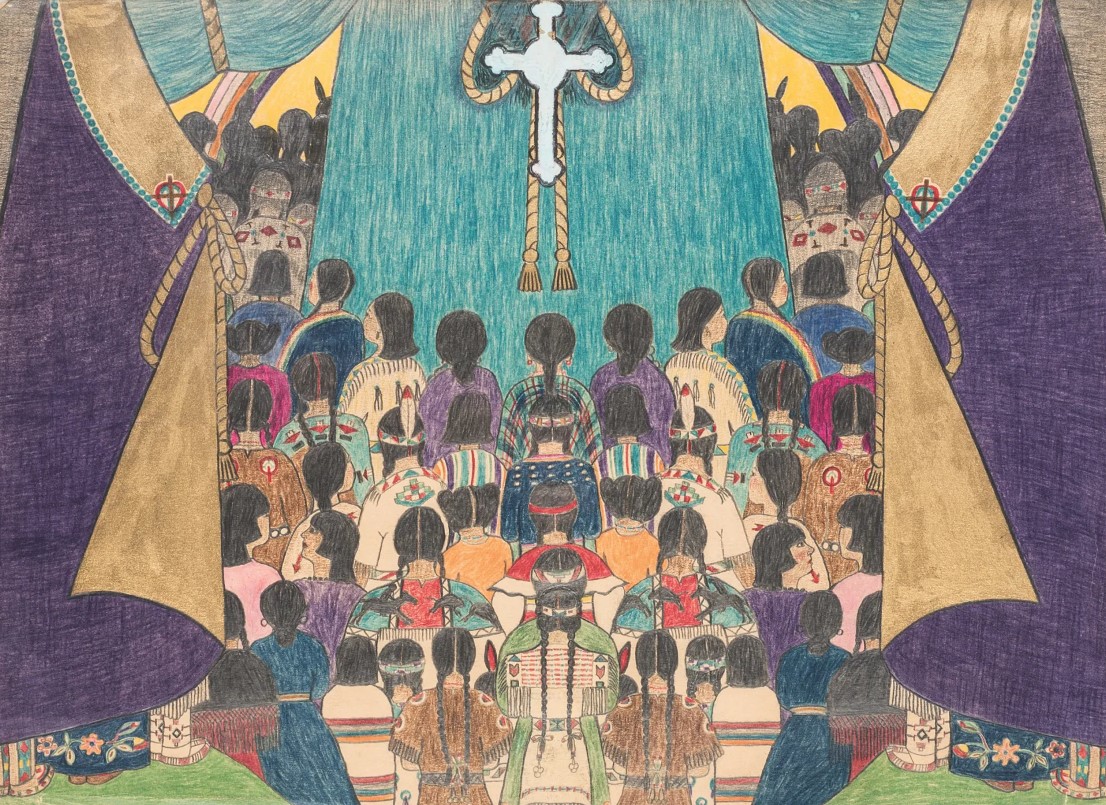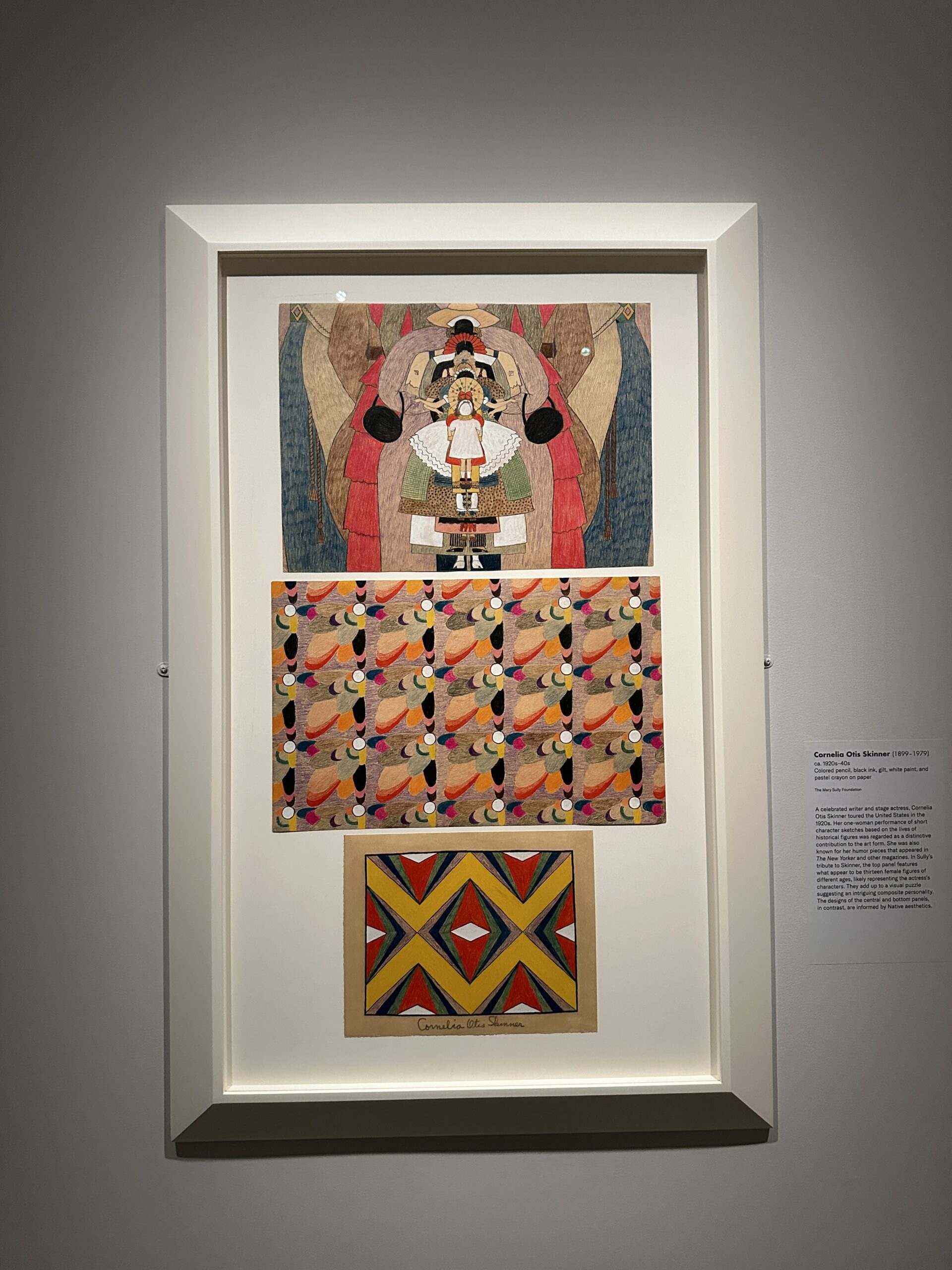Artist Mary Sully receives recognition she deserves

The “Indian Church” depicts a gathering of people assembled in front of an altar, which is surrounded by structures resembling tipi walls for protection.
“This is truly modern art, modern design, with its cross-racial themes, its fascination with celebrity and popular culture. There were moments when I thought, ‘Andy Warhol. She was here first.’” – Philip J. Deloria, great-grandnephew of Mary Sully and author of Becoming Mary Sully: Toward an American Indian Abstract
NEW YORK, NY – The Metropolitan Museum of Art is hosting a retrospective exhibition of the work of Yankton Dakota artist Mary Sully, who died in 1963. Born into an extraordinary family, Mary Sully, birth name Susan Deloria, was the sister of anthropologist Ella Deloria with whom she remained close throughout her life and the aunt of activist and historian Vine Deloria Jr, who authored “Custer Died for Your Sins: An Indian Manifesto.”
As we are sometimes blessed, a collection of three-panel drawings was discovered by family members after Mary’s death which ultimately proved that Mary Sully was way ahead of her time. Born on the Standing Rock Reservation in 1896, Mary was not exposed to the many advances in art and culture experienced back East. She was influenced heavily by Native American design patterns as well as the advertisements that would be found in newspapers and magazines that made their way West to her area. She created groundbreaking contemporary work that predated people such as the POP artists Andy Warhol, James Rosenquist and Roy Lichtenstein. Her compositions were structured in three parts showing the progression of a story and interrelated design components and borrows some aspects of the Native American winter count.
The complicated nature of her family raises many questions when one studies the influences on Mary Sully. Her mother was the second wife of painter and soldier Alfred Sully who is known as a fierce Indian-killing officer. The fact that Mary chose to take her father’s name in spite of his violent past perhaps is due to the fact the he and his father were both artists and she was following in their footsteps in that regard. Her grandfather Thomas Sully was a well-known portrait painter in Philadelphia and Alfred was an accomplished painting as one can see by this watercolor.
On May 16, 1863 Alfred Sully was sent to the Dakota Territory to serve in the Sioux Wars. Sully stated, “I can safely say that I gave them one of the most severe punishments that the Indians have ever received.” Mary was born several decades later.
By all accounts, Mary was a difficult woman. Such a word is frequently applied to creative people because, in general, they answer to the beat of a different drum. For a Native American woman artist to receive this degree of recognition is a true sign of the advances being made not only in America but around the world in terms of women and their achievements finally being acknowledged.
In the case of Mary, it has taken sixty years for a light to shine on her talents as an artist and the dedication of her great-grandnephew, Philip J. Deloria, a Harvard historian who wrote a book on her life and work.
As a self-taught artist, Mary worked in isolation yet loved Americana such as Babe Ruth and Fred Astaire, both of whom were subjects of her art. Though her work can be considered playful at times, it can also be extremely serious in exploring topics of religion, death and the afterlife.
It is commonly accepted in the art world that many artists produce their best work on paper. Paper allows for more spontaneity and can be less intimidating as a material therefore allowing the artist more freedom with less desire for control. The art of Mary Sully includes the tight structure of pattern and duplication of design as well as the freedom to juxtapose seemingly unrelated subjects organized in one of three panels to stimulate unconscious interpretation within the viewer. She was well ahead of her time, not only in terms of paving the way for contemporary art, but also in advances in psychology.
In 2019, Philip J. Deloria wrote the book, “Becoming Mary Sully: Toward an American Indian Abstract.” This text provides the foundation for the show at the Metropolitan as well as a number of other upcoming projects that are in discussion. The show at the Metropolitan continues till January 12, 2025. If you find yourself in New York City and are interested in Indigenous art and the influences that helped to shape the contemporary art world, I highly recommend this exhibition. It is a rare occurrence when a family member finds a box containing the almost complete work of an artist all together at once.
The Metropolitan Museum of Art is located at Fifth Avenue and 82nd Street in New York City.
(Contact Mia Feroleto at mia.feroleto@mail.com)
The post Artist Mary Sully receives recognition she deserves first appeared on Native Sun News Today.

